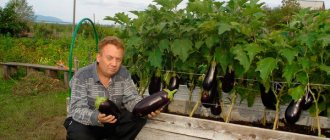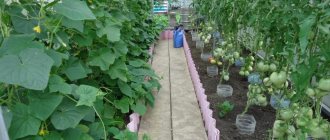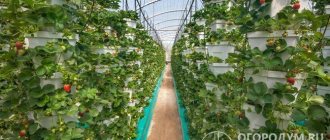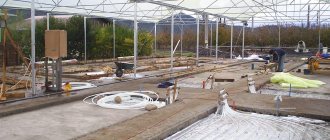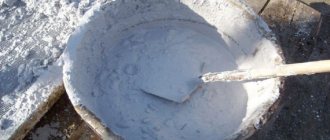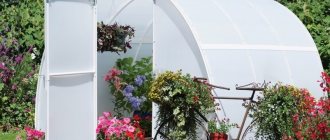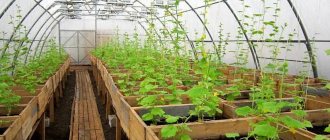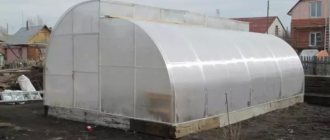With the end of the harvest season, we always draw conclusions about what the harvest was like and whether it is profitable to plant this or that crop on our plot. Such an analysis should be carried out by both novice gardeners and experienced gardeners. In order not to be left without your favorite crops, a number of works should be carried out to prepare future soil. Even if its depths are completely devoid of fertile layer, this is not a reason for disappointment. Will warm beds always come to the rescue, which need to be prepared this fall or spring? Let's talk about this below.
Arranging a warm bed in a greenhouse
An organic warm bed can be set up equally in open ground and in a greenhouse. The greenhouse provides an advantage for the northern regions. This means that the first seedlings can be planted in the beds under the greenhouse at the beginning of spring, and with the arrival of summer the first greenhouse fruits will be ready. Warm beds come in several types and shapes, but despite this, the earthen filling is laid out in a clear sequence. This is done so that the filler constantly works, interacts with each “ingredient” and heats up layer by layer from bottom to top.
Organically heated beds can be deepened, raised, pyramid-shaped, or even. They are arranged according to the same principle. The most common beds are those with sides made of slate, brick, and other materials that are used as improvised materials. They look impressive and at the same time neat. At first glance, few would guess that an orderly garden structure can produce profitable harvests for several seasons in a row. Preparation should be carried out from the first layer. To begin with, the bottom of the fruit-bearing structure is leveled and covered with sand.
A fine mesh net is placed on top of the sand cushion, with large branches on top of it, which will be the main ones in heating the layer. A layer of waste paper or beveled tops is placed on them. Then there are small branches, gradually the density of the filler decreases. Leaves and animal waste remained. Turf soil is laid out on top of a kind of organic pie, the bed is leveled and awaits its time to be planted. As a rule, beds of this type have 2 seasons: spring and autumn. The need for seasons is selected individually for each summer resident.
Advantages and disadvantages
Manufacturing heated structures in a greenhouse is a labor-intensive and costly process, but the opportunity to recoup the investment in 2-3 seasons attracts summer residents. The structures have several undoubted advantages:
- An increase in temperature accelerates the process of photosynthesis in plants;
- plants do not suffer from return frosts and temperature changes;
- fertilizer consumption is reduced due to their active decomposition in the soil;
- you can grow several crops;
- reducing the number of weeds.
There are significantly fewer disadvantages, but they are there:
- high cost of arranging beds;
- electricity and water heating costs;
- Increased temperature and humidity provoke increased growth of pathogens.
If the soil is heated by decomposing organic waste, a strong, unpleasant odor may occur in the greenhouse.
What to put first in a warm bed, and what to put next?
- Greenhouse beds are a great temptation for rodents and moles, who are always in a hurry to feast on the young and succulent shoots of newly planted plants. To prevent this from happening, we suggest laying thick PVC film on the bottom of the bed. It can be found in greenhouse or swimming pool stores. Next, it is worth laying a fine mesh on the surface so that rodents cannot penetrate into the layers of wood, tops and above;
- Now comes the important part of the bed - its fillers. Subsequently, water each layer generously to start the reaction. In the meantime, the first layer of organic masonry. It should be the most capacious in terms of heat transfer; before laying it, you need to make sure that this filler will not freeze. This feature applies to the northern regions. Therefore, in this case, you should take care of thermal insulation. A layer of plastic bottles would be suitable as a base for preserving heat. Fill them with air and screw the lids on them. This creates a space between the first fertile layer and the cold soil;
- Regions with a temperate climate can simply replace the bottle layer with a sand cushion. Next, a loose layer of wood is laid on the plastic/sand. This layer will be heating; in the future it must be maintained at constant humidity, because it is from this that the processes of decomposition of the biomaterial will be launched and heating will come from it. Small logs, driftwood, sawn trees, corn stalks or sunflower trunks can be used as wood filler. The wood should be approximately the same size so that the decomposition process occurs evenly. The layer height is 30-50 cm. The volume of wood filler will determine how long the warm bed will function. 30 cm is enough for about 5-8 fruiting seasons;
- The next layer consists of small sawdust, paper or cardboard. It will serve as a kind of guide to the next filling (10-20 cm);
- Branches of shrubs and trees are laid on top of the waste paper as laying material. The cut material must be free of rot and painful damage, so that infection does not develop inside the bed (20-25 cm);
- After this, recently fallen leaves are laid out. The layer should be approximately 25-30 cm;
- Animal waste, barnyard, and chicken droppings are laid out on top of the fallen leaves;
- The last and final warm bed will be a layer of turf soil. The bed is leveled and covered with film for 10 days. After this time, in the spring, ready-made seedlings can be planted into it. If you want to make a bed in the fall, complete it and cover the soil with mulch film. Leave it like this until the season opens.
What is a warm bed
A warm bed is essentially an improved compost heap. The bed consists of several layers of plant debris (weeds, fallen leaves, plant stems, branches, etc.). Decomposition releases heat, which helps plant roots cope with spring temperature changes. In addition, plant residues are an excellent organic fertilizer.
It’s easy to make a warm bed with your own hands
A warm bed, compared to a regular one, has a number of advantages:
- all organic remains (fallen leaves, weeds, plant stems, branches, etc.) are placed in warm beds;
- there is no need to dig up and weed the bed - weeds practically do not grow on it;
- There is no need to fertilize the garden bed for 4 seasons - decomposing organic matter provides the plants with all the nutrients;
- the carbon dioxide released during waste decay improves the photosynthesis of plants growing in the garden;
- sowing seeds and planting seedlings at an earlier date by warming the soil with decomposing plant residues;
- Plants in a warm bed are not afraid of return frosts.
The only disadvantage of warm beds is the time and effort spent on its production. But this disadvantage is compensated by an early high yield of large fruits.
My plot has clay soil and a high groundwater level. Therefore, making warm (high) beds is a salvation for me.
A warm bed can be made in the spring, but autumn is the best time to make it. In autumn there is a lot of organic waste and more free time.
High warm beds
One of the varieties of warm beds are high beds. They have been operating for 10 years. All the gardener needs is to make a good-quality bed with an earthen embankment on the sides and a high-quality substrate. In the future, only watering and fertilizing.
A high bed is made in 4 layers of organic substrate. First, a clear plan is made with the layout and size of the plantings, material for framing the sides and layer fillers are prepared. After this, you need to make markings, drive in stakes and secure the board. Wooden planks will last their entire service life if they are treated with an antiseptic.
It is easier to dig up soil in a ready-made box, because... the boundaries of the bed are known. The recommended depth and height of the bed is 2 shovels down and 2 shovels up. The upper part will shrink over time and become much lower. When the niche for the layers is ready, a greenhouse film is first laid out on the bottom of the box, with a metal mesh on top. Next, large branches, rotten logs, and boards are filled in. To eliminate gaps, the earth is filled up. This way the layer will sag less.
After adding soil to the wood layer, water the surface generously and begin laying a new layer consisting of knots, paper, sawdust or cardboard. Water again, lay out small branches, you can add straw and tops. We do not spare water, we make a new gap from leaves. It will be the final one before the layer with humus. We water the compost on top, lay a layer of fertile soil and let the bed sit until spring.
What to put
You need a heating component. This could be manure, compostable crop residues, and so on. An obligatory component is slowly decomposing organic matter: sawdust, small branches, twigs and other waste from pruning trees and shrubs of any species.
| You can put any cellulose, for example, dry plant stems. This filling will retain moisture. It will release juices as the plants need them. |
The composition can include any rotten or damaged fruits and vegetables that you would simply dispose of. You can put any apples, potatoes, leftover peels, rhizomes of any plants. If these are the roots of tree crops or shrubs, then it is better to split the rhizomes into pieces.
Photo: A warm bed is a “pie” consisting of several layers.
Nutrient soil is appropriate in the composition. It should be free from weed roots and weed seeds. Soil is a source of microorganisms that accelerate the processing of all organic matter. Without soil, all these processes will go much slower.
When is it better to make a warm bed in autumn or spring?
Autumn and spring beds with organic filler have their pros and cons. Some gardeners recommend harvesting such structures in late autumn, and some advise not to delay using the fertile layer and begin exploitation immediately after harvesting, in the spring. From the experience of gardeners, it can be noted that after harvesting in the autumn, a lot of plant residues remain, which are perfect for an organic cushion in a warm garden bed.
In addition to this, in the fall, although late, the earth has not yet had time to freeze, which means that you do not have to dig up a frozen layer of earth and wait for it to thaw. Autumn time is also good because the bed cushion begins to work; over the winter the structure will sag and the seedlings will receive the first dose of rotted fertilizers, which will undoubtedly affect the harvest. However, autumn beds also have some disadvantages. Primarily they concern rodents. All the mice and moles that flee from the fields can find out about the biological filler and stay in the bosom of the beds for the winter. During this period, rodents will cause a lot of trouble. To avoid such troubles, it is recommended to carefully protect the beds, regardless of whether they are in autumn or spring, with a metal mesh pad, as well as with light-proof thick film.
If you look at it from the point of view of labor costs, spring means a number of gardening jobs. Few people will want to conduct experiments during the period of sowing seeds, opening and developing soil, and other matters. But, despite this, spring is the time of year when water independently feeds a multi-layered bed, thereby heating the fruiting layers. In general, if you have the strength and desire, then warm beds will take root at any time of the year.
Where to place
Before manufacturing, you need to decide on the location of its placement. The best option is a well-lit and sun-warmed part of the site. There are information and recommendations about location in a shaded area. Ostensibly to save irrigation water, but such placement is not justified. Indeed, less moisture is required in the shade, but the plants will grow worse and produce a modest harvest.
| In open areas, plants grow well and yields are high. The only thing that will need to be provided is the supply of moisture throughout the entire growing season of the plant. |
Photo: The ideal site is a well-lit place.
Warm bed in a greenhouse in autumn
Greenhouse beds are limited in the size of cultivation. Before preparing them, you first need to correctly distribute the sizes. Draw up a diagram that clearly defines the dimensions of the boxes and places for passage. When the diagram is ready, mark the locations for the trench. Place the first removed layer near the future bed. The depth of the trench must be at least 40 cm to accommodate all organic fillers. A greenhouse bed will be much warmer and more efficient than an outdoor one, so you don’t have to put tree branches or rotten logs into it. We suggest going straight to the plant layer.
If you don't have a metal mesh, use prickly branches of raspberries, gooseberries or spruce leaves. Rodents do not like discomfort at all. The next layer will be the removed turf. Turn it over with the grass side down and place it on the bottom. Water the fruiting layer with urea or a solution that accelerates decay. Next, lay a layer of tops, leaves, and water again with an aqueous solution. Finally, fertilize the layer with manure and add a layer of turf soil on top. Cover the greenhouse bed with film and leave it until spring.
Warm bed in a greenhouse in spring
Arranging a warm bed should be started at the moment when the ground has thawed from ice and cleared of snow. Icy soil will prevent the reaction from starting. As soon as the earth has warmed up, you can start making a box (made of wood, plastic, metal, slate) and digging out the earth. However, the most accessible material for gardeners has always been wood. Hands often get cut on slate, and plastic and metal are too expensive. When designing, it is worth considering the fact that instant construction of a bed will not result in the same rapid shrinkage of the soil. The top layer will have to be made above the level of the frame so that the crop does not sink below the natural earthen layer.
The layers of the spring bed will be the same as the filling of the autumn heating pillow, we wrote about them above: a wooden layer (optional), paper, vegetable, manure, earthen. Layers for a warm spring bed must be carefully compacted. Only you need to tamp not with your feet, but with a wooden plank, a thick plastic panel or, as in the photo, an old wooden door, so that shrinkage under the press occurs evenly. Compaction is carried out from the beginning to the end of the bed. The plank is laid on each layer, and under the weight of a person, the fruit-bearing rows are compacted. As compaction progresses, the bar moves.
The top layer of soil in a warm spring bed should be at least 30 cm. Otherwise, the plants may burn from the high temperatures emanating from the organic layer. In addition, do not forget about soil shrinkage. To make the greenhouse with beds work as efficiently as possible, it is recommended to place bottles of water between the rows during the cold season. Bottles must be black. When sunlight penetrates, the container will heat up, and accordingly, the liquid will heat up, and, as a rule, this will make the earth warmer than usual, which will have a beneficial effect on the course of the reaction.
Is manure needed for warm beds?
Manure in warm beds acts as a warming substrate, which simultaneously nourishes the soil with various elements and provides it with gas exchange. Manure is especially needed in cold northern lands. Just imagine, the manure layer can maintain a temperature of about 75ºC for 1.5 months. And this will be just enough until the onset of natural warming.
Manure is mixed with straw and used to grow champignons, cucumbers, tomatoes, and zucchini. Often the manure layer is laid down first to act as a sort of fire starter for the organic bed. It is worth cultivating such beds in a place where there is a lot of sun. With its help, the reaction will be supported with double the effect. The manure will warm the bed from below, and the sun will warm it from above. For the winter, the manure bed is sown with green fertilizers, for example, mustard or rye. As soon as the grass grows, it is cut and scattered over the ridge. Thus, manure will enhance the reaction of heat and gas exchange.
Option #2 - we heat the bed with pipes
Long before the advent of electric cables and warm infrared floors, beds in greenhouses were heated with pipes - they simply ran them underground and ran warm water through them. The water came out already cooled and was heated again in the boiler. Very quickly, gardeners realized that it was easier and more economical to heat just a few beds than to heat the entire greenhouse at once, and especially its air, which, when heated, of course rushed upward. And warm beds with pipes turned out to be effective. As for the boiler, for these purposes it is better to take a gas one, and to circulate water in the system, purchase a pump and an automatic thermostat.
Take pipes for constructing such a warm bed from copper or plastic. The latter are good because they are cheap, lightweight and resistant to corrosion.
The main advantage of this method of making warm beds with your own hands is the simultaneous heating of both air and soil.
Cucumbers and warm beds
In the first year of life, warm beds intensely release nitrogen. Therefore, it would be logical to plant crops on them that require this particular element. These include cucumbers. Warm beds for cucumbers are erected both in the greenhouse and in the open ground. At the same time, in the greenhouse the beds are placed at a height, and in the open air they are deepened. Another difference between a greenhouse bed and a ground bed is the first layer. In the greenhouse it should be more porous. It is better to pour drainage at the bottom: small stones, broken bricks. It is better to place tree branches in the ground. The rest is a classic sequence.
For cucumbers, the filling must be manured. Any manure can be used, except chicken and horse manure. It is best used for autumn preparations. For spring ones, it is better to take a mixture of cow manure and straw. The last layer in a warm bed is always the turf layer. The soil is watered with hot water, left under film for 3 days in a greenhouse and for 7 days in an open bed, after which the first seeds can be planted. A reaction will occur from the water and the structure will begin to work.
Another feature for growing cucumbers in a warm bed is the need to construct arcs. Cucumber vines will bloom along them. In addition, for the gardener this is a help in harvesting. The spacer made of arcs can be replaced with vertical tying of lashes. Such a structure is most convenient to erect in a greenhouse.
Types of warm beds
Depending on how the soil is heated in warm beds, they come in three types:
- Biological heating beds soils consume heat released during the decay of biomaterial in the form of animal waste and plant residues, which, accordingly, divides warm biobeds into several subtypes depending on the method of using biomaterials and their types.
- Heating the soil using electricity involves laying heating cables under the bed, which, thanks to the power supply control system, is very functional, but at the same time quite expensive.
- Water heating of the soil is carried out using pipes laid under the bed, through which pre-heated water is passed, which also requires considerable costs for equipment and operation.
Tomatoes and warm beds
Warm beds for tomatoes perform best in open soil. They need to be installed from north to south in order to get the maximum amount of light, which is so necessary for the full ripening of tomatoes. The optimal width of a tomato ridge is considered to be 60-80 cm. They are convenient to process and harvest from. It is better to prepare a heating pad in the fall. Until spring, the bed will sag and acquire its permanent shape, thereby the soil will not injure the root system of the tomatoes.
A garden bed is suitable for growing tomatoes in the first three years of life. During this period, under the influence of internal microorganisms, the soil produces the elements necessary for them. And then the soil will be ideal for cabbage, celery, and herbs. As soon as the soil temperature has reached 10 degrees, the bed is watered abundantly with warm water to start the reaction, it is kept for 2-3 days and the first seeds can be planted. The internal temperature is quite enough for night and day heating.
Seeds are sown under a cover made of plastic bottles. 3-4 tomato seeds are buried in each hole, and a pale pink solution of potassium permanganate is poured over the material. The soil is sprinkled on top of the seeds to a height of 2-3 cm. At night, warm beds are covered with covering material directly on top of the plastic. This must be done until the temperature reaches above zero. At the beginning of May, the seedlings will be fully grown and the plastic caps can be removed from them. The bushes may seem sluggish for the first two days, but moderate watering will correct the situation.
On warm ridges, tomatoes feel much more comfortable, and the harvests differ in weight and quality. For example, varieties that have not previously ripened grow faster and turn out just like in the picture. Tomato bushes grow due to the abundant supply of nutrients, do not be afraid of this, remove weak side shoots and leave stronger ones for further growth and development of fruits, and so that the bushes have an orderly appearance, tie them up.
Advice from experienced summer residents on creating smart beds with their own hands: video and technology
Tips from experienced summer residents on creating warm beds in the spring:
the process of decomposition of organic matter can be accelerated. For this purpose, special preparations are used that are characterized by biological activity;
A high warm bed can easily be converted into a greenhouse
- The soil in high beds needs frequent watering. Abundant moisture promotes the decomposition of the lower layer of fertilizers, which provides the plantings with additional heat;
- if wood is used as a building material, before making a warm bed for cucumbers, you must first treat all structural elements with an antiseptic. Lumber needs protection from rotting. Hot drying oil, which is used to process wooden blanks, will help achieve an excellent result.
Pepper and warm beds
Is it possible to grow peppers in warm beds? Many gardeners are afraid of the high temperature conditions of the nutrient bed. In fact, there is no need to doubt the landing. As soon as the pepper has acquired its first green leaves and has stretched out, it needs to be planted in a warm bed. The fact is that pepper loves heat. To transplant it into open ground, you need to wait for the ground temperature to be at least 25ºC. The root system of this vegetable is very sensitive, so a warm organic bed is the ideal solution.
As with all of the above crops, a warm bed is first watered with hot water, left to settle for 3 days, and then replanted. The finished sprouts are buried in soil, watered and covered with film. The protective material is stretched along pegs or arcs installed on the bed. With the arrival of constant heat, the film is removed. Thus, the pepper will be in an artificial greenhouse and protected from sunburn.
Step-by-step making of warm beds with your own hands in the spring: popular technologies
From this article you can find out in what order the step-by-step production of warm beds with your own hands in the spring is carried out, as well as familiarize yourself with the basic rules of soil cultivation and preparation, study the most popular technologies for making structures for growing various vegetable crops, get access to basic information and video reviews . The text describes in detail the method of arranging a vegetable garden, recommended by Igor Lyadov.
With the help of high beds for heat-loving vegetable crops, you can properly organize the space in your garden and get a rich harvest



